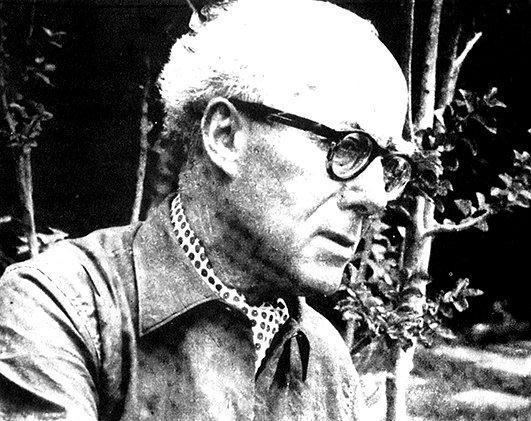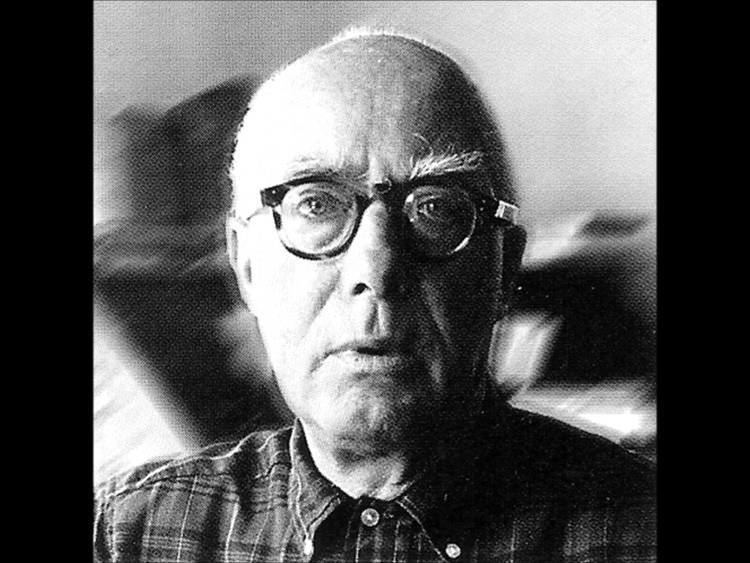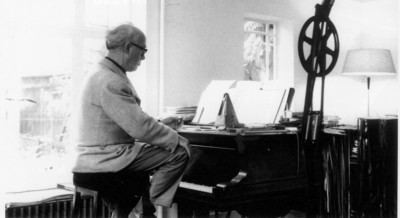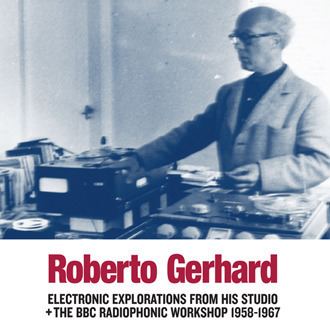Name Roberto Gerhard Role Composer | Books Concerto for Orchestra | |
 | ||
Compositions Hymnody, Hymnody, Pandora Suite: I "The Quest", Pandora Suite: I "The Quest", Symphony no 2 "Metamorphoses": Ib Allegro assai, Symphony no 2 "Metamorphoses": Ib Allegro assai, La Peste: VIII "L'Agonie de l'enfant", La Peste: VIII "L'Agonie de l'enfant", Symphony "Homenade e Pedrell": I Allegro (moderatamente), Symphony "Homenade e Pedrell": I Allegro (moderatamente), Symphony no 3 "Collages": VII Calmo, Symphony no 3 "Collages": VII Calmo, Violin Concerto: III Allegro con brio — Presto, Violin Concerto: III Allegro con brio — Presto, La Peste: IX "La Fin soudaine de l'epidemie", La Peste: IX "La Fin soudaine de l'epidemie", Dances from Don Quixote: IV In the Cave of Montesinos, Dances from Don Quixote: IV In the Cave of Montesinos, Concerto for Harpsichord - Strings and Percussion: II Largo, Concerto for Harpsichord - Strings and Percussion: II Largo, Symphony no 1: II Adagio, Symphony no 1: II Adagio, Symphony no 3 "Collages": IV Moderato, Symphony no 3 "Collages": IV Moderato, Wind Quintet, Wind Quintet, Cancionero de Pedrell: IV "Soledad" (Asturias), Cancionero de Pedrell: IV "Soledad" (Asturias), Pandora Suite: III "Psyche and the Youth", Pandora Suite: III "Psyche and the Youth", Alegrias: II Farruca y jaleo, Alegrias: II Farruca y jaleo, Concerto for piano and strings: II Diferencias Adagio, Concerto for piano and strings: II Diferencias Adagio, Symphony "Homenade e Pedrell": III Pedrelliana: Allegretto giusto, Symphony "Homenade e Pedrell": III Pedrelliana: Allegretto giusto, La Peste: V "La Fermeture des portes de la ville", La Peste: V "La Fermeture des portes de la ville", Dances from Don Quixote: III The Golden Age, Dances from Don Quixote: III The Golden Age, Cancionero de Pedrell: V "Muera yo" (Asturias), Cancionero de Pedrell: V "Muera yo" (Asturias), Cancionero de Pedrell: II "La mal maridada" (Catalonia), Cancionero de Pedrell: II "La mal maridada" (Catalonia), Cancionero de Pedrell: III "Laieta" (Catalonia), Cancionero de Pedrell: III "Laieta" (Catalonia), Nonet: I Introduction, Nonet: I Introduction, 2 apunts - num 1, 2 apunts - num 1, La Peste: III "Choc sur la population", La Peste: III "Choc sur la population", Dances from Don Quixote: I Introduction, Dances from Don Quixote: I Introduction, La Peste: VII "Les Enterrements", La Peste: VII "Les Enterrements", Pandora Suite: VI "Death and the Mothers", Pandora Suite: VI "Death and the Mothers", Cancionero de Pedrell: VII "Alata" (Galicia), Cancionero de Pedrell: VII "Alata" (Galicia), Symphony no 2 "Metamorphoses": Id Lento, Symphony no 2 "Metamorphoses": Id Lento, Violin Concerto: II Largo — Allegretto placido, Violin Concerto: II Largo — Allegretto placido, Symphony no 2 "Metamorphoses": Ia Poco sostenuto, Symphony no 2 "Metamorphoses": Ia Poco sostenuto, Cancionero de Pedrell: VIII "Corrandes" (Valencia), Cancionero de Pedrell: VIII "Corrandes" (Valencia), La Peste: I "Oran", La Peste: I "Oran", Symphony no 3 "Collages": V Vivace, Symphony no 3 "Collages": V Vivace, Symphony no 3 "Collages": III Allegro con brio, Symphony no 3 "Collages": III Allegro con brio, 2 apunts - num 2, 2 apunts - num 2, Symphony no 1: I Allegro animato, Symphony no 1: I Allegro animato, Piano Trio no 1: III Vif, Piano Trio no 1: III Vif, Alegrias: I Preambulo - Jacara, Alegrias: I Preambulo - Jacara, Symphony no 3 "Collages": VI Allegretto, Symphony no 3 "Collages": VI Allegretto, La Peste: VI "La Mort de la jeune fille", La Peste: VI "La Mort de la jeune fille", Sept Haiku: II "J'ai caresse ta flottante", Sept Haiku: II "J'ai caresse ta flottante", Violin Concerto: I Allegro cantabile - con anima — Molto vivace - con spirito, Violin Concerto: I Allegro cantabile - con anima — Molto vivace - con spirito, Sept Haiku: IV "Douce voix", Sept Haiku: IV "Douce voix", Sept Haiku: III "Sous les lucioles", Sept Haiku: III "Sous les lucioles", Sept Haiku: VI "Sous la pluie d'ete", Sept Haiku: VI "Sous la pluie d'ete", Symphony "Homenade e Pedrell": II Andante (un poco adagio), Symphony "Homenade e Pedrell": II Andante (un poco adagio), Epithalamion, Epithalamion, Piano Trio no 1: I Modere, Piano Trio no 1: I Modere Similar People Xavier Montsalvatge, Matthias Bamert, Geoffrey Tozer, Enrique Granados, Manuel de Falla | ||
Roberto gerhard symphony no 4 new york
Robert Gerhard i Ottenwaelder ([ruˈβɛrd ʒəˈɾart]; 25 September 1896 – 5 January 1970) was a Spanish Catalan composer and musical scholar and writer, generally known outside Catalonia as Roberto Gerhard.
Contents
- Roberto gerhard symphony no 4 new york
- Roberto gerhard don quixote 1940 1941 rev 1947 1949
- Life
- Stylistic evolution
- Selected list of works
- Symphonies
- Stage works
- Concertos
- Orchestral works
- Chamber and instrumental music
- Vocal works
- Electronic music
- Fantasias on themes from Zarzuelas
- Film music
- Articles by Gerhard
- References

Roberto gerhard don quixote 1940 1941 rev 1947 1949
Life

Roberto Gerhard was born in Valls, near Tarragona, Spain, the son of a German-Swiss father and an Alsatian mother. He was predisposed to an international, multilingual outlook, but by birth and culture he was a Catalan. He studied piano with Granados and composition with the great scholar-composer Felipe Pedrell, teacher of Albéniz, Granados and Falla. When Pedrell died in 1922, Gerhard tried unsuccessfully to become a pupil of Falla and considered studying with Charles Koechlin in Paris but then approached Arnold Schoenberg, who on the strength of a few early compositions accepted him as his only Spanish pupil. Gerhard spent several years with Schoenberg in Vienna and Berlin. Returning to Barcelona in 1928, he devoted his energies to new music through concerts and journalism, in conjunction with the flourishing literary and artistic avant-garde of Catalonia. He befriended Joan Miró and Pablo Casals, brought Schoenberg and Webern to Barcelona, and was the principal organizer of the 1936 ISCM Festival there. He also collected, edited and performed folksongs and old Spanish music from the Renaissance to the eighteenth century.

Identified with the Republican cause throughout the Spanish Civil War (as musical adviser to the Minister of Fine Arts in the Catalan Government and a member of the Republican Government's Social Music Council), Gerhard was forced to flee to France in 1939 and later that year settled in Cambridge, England. Until the death of Francisco Franco, his music was virtually proscribed in Spain, to which he never returned except for holidays. Apart from copious work for the BBC and in the theatre, Gerhard's compositions of the 1940s were explicitly related to aspects of Spanish and Catalan culture, beginning in 1940 with a Symphony in memory of Pedrell and the first version of the ballet Don Quixote. They culminated in a masterpiece as The Duenna (a Spanish opera on an English play by Sheridan, which is set in Spain). The Covent Garden production of Don Quixote and the BBC broadcasts of The Duenna popularized Gerhard's reputation in the UK though not in Spain. During the 1950s, the legacy of Schoenbergian serialism, a background presence in these overtly national works, engendered an increasingly radical approach to composition which, by the 1960s, placed Gerhard firmly in the ranks of the avant-garde. From the early 1950s Gerhard suffered from a heart condition which eventually ended his life. He died in Cambridge in 1970 and is buried at the Parish of the Ascension Burial Ground in Cambridge, with his wife Poldi, Leopoldina 'Poldi' Feichtegger Gerhard (1903–1994).
His archive is kept at Cambridge University Library. Other personal papers of Robert Gerhard are preserved in the Biblioteca de Catalunya.
Stylistic evolution
For twenty years – first in Barcelona and then in exile in England – Gerhard cultivated, and enormously enriched, a modern tonal idiom with a pronounced Spanish-folkloric orientation that descended on the one hand from Pedrell and Falla, and on the other from such contemporary masters as Bartók and Stravinsky. This was the idiom whose major achievements included the ballets Soirées de Barcelone and Don Quixote, the Violin Concerto and the opera The Duenna.
Gerhard often said that he stood by the sound of his music: 'in music the sense is in the sound'. Yet dazzling as their scoring is, his last works are in no sense a mere succession of sonic events. Their forms are meticulously organized and several make use of his special development of serialism where a twelve-tone pitch series, governing intervallic relations, interacts with a twelvefold time series governing the music's duration and proportions.
Selected list of works
Gerhard's most significant works, apart from those already mentioned, include four symphonies (the Third, Collages, for orchestra and tape), the Concerto for Orchestra, concertos for violin, piano and harpsichord, the cantata The Plague (after Albert Camus), the ballets Pandora and Ariel, and pieces for a wide variety of chamber ensembles, including Sardanas for the indigenous Catalan street band, the cobla. He was perhaps the first important composer of electronic music in Britain; his incidental music for the 1955 Stratford-on-Avon King Lear – one of many such commissions for the Royal Shakespeare Company – was the first electronic score for the British stage.
Symphonies
Stage works
Concertos
Orchestral works
Chamber and instrumental music
Vocal works
Electronic music
Fantasias on themes from Zarzuelas
(for light orchestra; composed c. 1943 under the pseudonym "Juan Serralonga")
